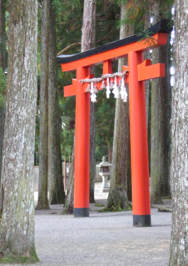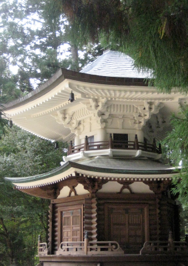KOYASAN
island of Honshu
KANSAI REGION, WAKAYAMA prefecture
MT, KOYA, Japan
October 16 - 18 , 2007

KOYASAN
island of Honshu
KANSAI REGION, WAKAYAMA prefecture
MT, KOYA, Japan
October 16 - 18 , 2007



In the diary of our travels to date, Henry and I consider our journey to Koyasan on Mount Koya as one of our most inspiring. The mountain, 820 meters/2,690 feet above sea level. is situated south of the river Kinokinokawa in Ito County and Wakayama Prefecture. This magical and spiritual place is venerable to the Japanese and is a place of pilgrimage for those who take their Buddhist faith seriously. During their lifetimes, Japanese Buddhists might visit Koyasan several times; and, often planning their burial in preparation for death, with the spiritual and practical support of the esoteric teachings in the Kyosan Shingon temples here. Koyasan, a World Heritage site since 2004, has 117 temples. It was founded by Kukai, also known as Kobo-Daishi*1, who in 804 at the age of 15 traveled to China. He studied with Hingong in Changan, where he mastered Shingon Mikkyo Buddhist teachings in just eight months. He returned to Japan to propagate the esoteric teachings and followed the Chinese argument that it is possible to attain Buddhahood within this existence. From his base in Kyoto, Kukai experienced the necessity to withdraw to the mountains to follow his ascetic practices. He built a prayer hall deep in the mountains as “a protection of the imperial realm through the powers of Buddhism and the salvation and benefit of the people”. In 816 he received a land grant from the emperor allowing him to develop Mount Koya as a grand monastic complex.*2 When this complex was dedicated in 819, Kukai stated his vision that “All beings in this world ultimately vanish, but I shall work towards the salvation of all sentient beings until the day the Dharma (Buddha law) comes to an end.” He entered his final “repose” as he had predicted, in 835, just months after his monastic complex was recognized by the emperor and the state. He is thought to still be meditating for us in a state of sleep or repose. I witnessed three monks in golden robes deliver a chest of food to the mausoleum of Kukai, where he is thought to have been meditating for 1,172 years to date. His teachings and his presence is very alive and tangible in Koyasan, especially at the Okunoin Shrine. When we visited, approaching it by walking at least two miles along a densely wooded stone path with hundreds of centuries-old terraced burial stones, Henry and I were surprised to find ourselves, at the end, in a very auspicious place. A large wooden building, the Toro-do, or Lantern Hall, with temple-like in architecture, stood at the end of this pathway. The massive doors, ornamented with polished brass medallions, were open. As I stepped over the threshold, my eyes adjusted to the dim light of the interior to notice the yellow ochre walls and ceilings plus the thousands of lanterns hung there and placed nearby. All the lanterns were of a single design, bordered in black, and flickering with a faint amber light. The hall itself dates from 1023, and some of the lanterns are said to have been burning for 900 years. There was a wooden counter that ran the entire length of the room dividing it into two parts. The foreground was reserved for petitioners, those who wanted a favor, or a prayer answered. The background housed several monks in golden hued robes. The atmosphere in the room was scholarly, serene and deeply reverent. In one of the background spaces, a fire, attended by a monk, roared with flickering flames. An opening in the far background revealed a scene outside. Curious, we walked around the building, following arrows to this same spot. When there, we encountered a monk chanting before the Mausoleum of Kobo-Daishi in repose. Three or four people were in prayer. We made an offering, prayed and removed ourselves. The next place we found through the directional arrows was a Muen Botoke, a shrine in a conical arrangement of stone carvings representing unknown souls. Some of these carvings were dressed in red bibs to signify children who had died too young. We left the compound, walking an alternate pathway to a shrine called Karukaya-do, the site of a tragedy. It is named for a man, Karukaya Doshin, who renounced his lay life to escape his jealous wife. To further protect himself, he hid his identity from his son who came looking for him in the temple. Onward, though relatively new grave sites on our exit, we found one with the corporate emblem of Nissan in chrome on a grave stone, and another in the shape of a four-stage rocket. There is obviously room in the this world and the next one for self aggrandizement. After a quick lunch in a charming new “Art Work” restaurant in Koyasan, Henry and I ventured onward to see more of the sacred sites. First we came upon the Buddhist teaching center, Daishi Kyokai, which was built in 1925. It’s stones look new compared to so much of what we saw that morning. In a small shrine at the gate of these grounds, was a figure known as the “Red Jizo”, bright red in color and dressed in a series of red bibs. Surrounding him were offerings of fruit, vegetables including sweet potatoes and Daikon radishes displayed like candles, and cellophane wrapped Japanese-manufactured food products. This little red Buddha with halo is still a mystery to me -- but he was cute! On a more serious note, we found the ochre colored earthen path which led to a very important site, the founding site of Koyasan, where Kukai built buildings for his monastic complex. This area, containing 19 structures is called the Garan. Most prominent among them is the orange colored Great Stupa with an smaller, older dark red stupa next to it. Noteworthy was the Me-Do, a large, square, squat building which was Kukai’s private place of worship. Next to it, was a small temple building, built in 1198 on the orders of a retired empress, daughter to Emperor Toba. It is named for one of the five guardian wisdom dieties of Buddhism, Fudo. Referred to as the “Fudo-do” it is listed as a Japanese National Treasure. Taking center stage in this compound is a large wooden building with beautiful rice paper sliding doors and elaborate eaves. Called “Kondo”, it has played a major role in all of Koyasan’s history, primarily functioning as a lecture hall, or Kodo, as well as a temple. Almost directly behind the Garan compound is the Koyasan Reihoken Musem, which holds art and artifacts related to Buddhism. I was interested in the stylized scroll painting that depicted Kukai in China. This world headquarters of the Koyasan Shingon became a UNESCO World Heritage Site as part of Sacred Sites and Pilgrimage Routes in the Kii Mountain Range. Eight peaks, resembling a lotus plant, surround the town of Koya, dedicated to religious studies.
*1 Kukai (Kobo Daishi) played an active role in many fields, performing rituals for the emperor, constructing a large reservoir in Shikoku for the common people, and establishing the first school for common citizens. His legend is riddled with folklore. He is one of Japan’s most celebrated calligraphers and supposedly published Japan’s first dictionary. He became a major patron of the arts, and reportedly, founded hundreds of temples across Japan. The Shikoku Pilgrimmage to 88 Sites is a popular pilgrimage attributed to Kukai. Most devotees carry a staff bearing the words “we two walk together.”
*2 When the emperor granted Mt. Koya to Kobo-Daishi in 816, he sent his disciples to explore the mountain. They cleared the precinct called Daino on the mountain. Kobo Daishi planned to establish a monastery, shrines of the guardian divinities, and a grand stupa. The task was proven to be extremely difficult, yet he succeeded in establishing the Monastery Chun as the residence for himself and his disciples.
PHOTOS: Left Column: 1. Muen Botoke, a shrine in a conical arrangement of stone carvings representing unknown souls, some wearing red bibs. 2. Monks at Okunoin Shrine transporting food to Kukai’s Mausoleum, located behind the Toro-do, or Lantern Hall. 3 The Hall of Worship stands in front of the Shrines of the Divinity. This is used by the priests for discussions on fixed dates.. 4. Along the Cedar walk are clusters of ancient burial stones, most covered with moss, lending a sacred and timeless atmosphere to the area. Center Top: Dai-to, the Great Stupa. Center, Bottom: The walkway through towering ancient cedar trees, as viewed from a bridge. Right Column: 1. A group of Burial Stones. 2. A monk at Garan ringing the bell. He has turned to move stones from left to right to record the number of gongs he has rung with a tree trunk suspended from chains against a beautiful bonze bell. 3. Shrine amongst the cedar trees. 4. One of several shrines on Mt. Koyasan. The shrines are dedicated to Goddess Nyu, God Koya (Kariba) and modern divinities. Kobo-Daishi invited the guardian divinities of Koyosan from Amano at the foot of Koyasan Priests in the mountain have worshipped the Nyu and Koya since old time.


LIVING SPIRIT






